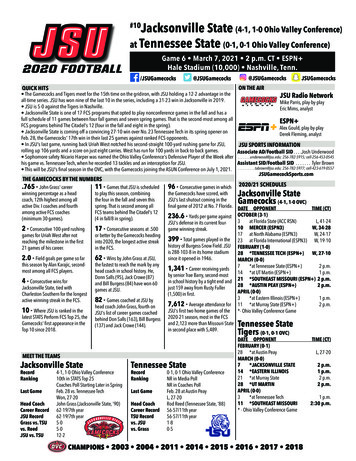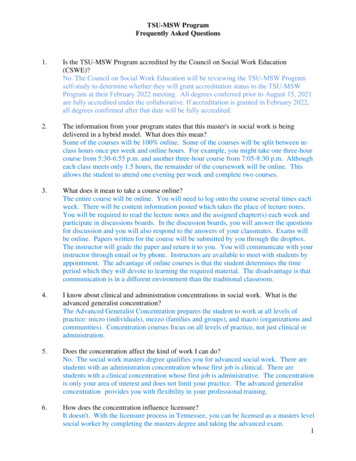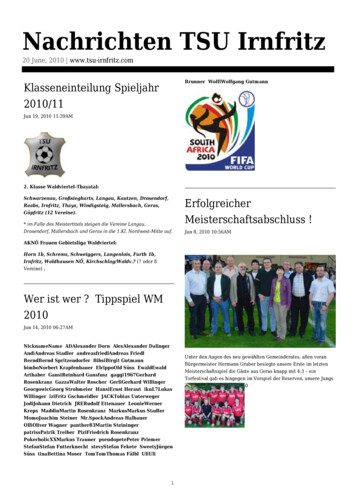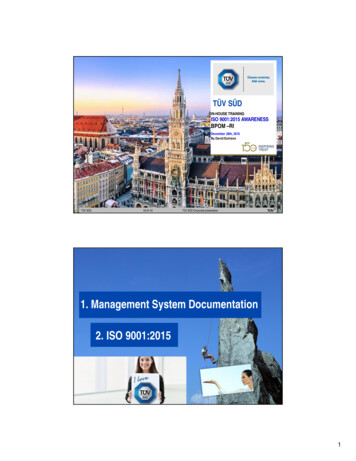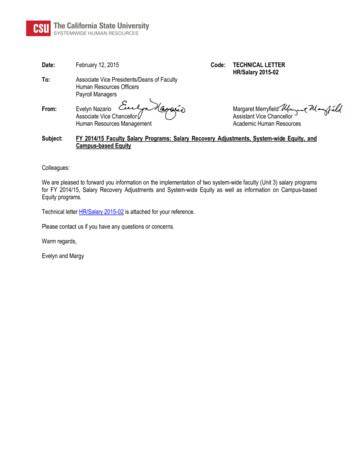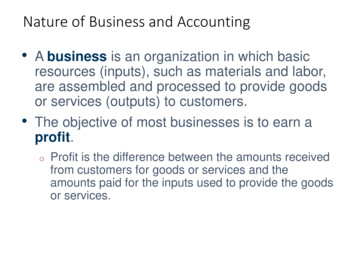
Transcription
TSU 2015TRANSFORMINGTENNESSEE STATE UNIVERSITY2010-2015 Strategic Plan Goals and ExpectationsEXECUTIVE OVERVIEW
TSU 2015To accomplish greatthings, we must notonly act, but alsodream; not only plan,but also believe.-- Anatole France,Nobel LaureateTennessee State University (TSU), a Historically Black College/University (HBCU) and an 1890 land-grant institution, isNashville’s only urban and comprehensive public University, as well asmiddle Tennessee’s first public Carnegie Doctoral/Research institution.TSU offers 7 doctoral programs, 24 Master’s, and 42 Bachelor’s degreesin numerous disciplines. Its location in the state capital, a federal gatewayto America’s south and a major hub for healthcare, music, banking,publishing, and transportation industries, offers unparalleled researchand service opportunities to students, scholars, and business partnersfrom around the globe. Nearly 430 full‐time faculty and approximately200 part‐time faculty serve a student population of over 8500 drawn from42 states and 45 countries. More than 70% of the student populationis African American, while 22% is white. A growing number of Latino,Asian, and international students is also present at the University.TSU’s unique characteristics differentiate it from other institutionsthroughout the state and inform the three central pillars of its missionstatement: to foster scholarly inquiry and research, life-long learning, anda commitment to service. These central pillars of the mission statementare also inextricably linked to the University’s motto: Think, Work, Serve.For many decades, the unique characteristics, the mission statement, andthe motto have shaped the way the University projects itself to its manyconstituencies of students, alumni, staff, and the community. Moreimportantly, they have shaped the University’s planning goals and strategicdirection.
TSU 2015Tennessee State UniversityMission StatementTennessee State University, a Historically Black College/University(HBCU), fosters scholarly inquiry and research, lifelong learning, and acommitment to service.Vision StatementTennessee State University aspires to achieve national and internationalprominence, building on its heritage and preparing leaders for a globalsociety.Core ValuesTennessee State University maintains the following corevalues: ExcellenceLearningAccountabilityIntegrityShared governanceDiversityService
OURPLANTSU 2015Shared goals, common themes, and core expectationsFour major planning documents drive the University’s planninggoals and strategic direction. These documents include theAcademic Master Plan 2008-2028: Envisioning the Future throughthe Lens of our Heritage; 2010-2015 Strategic Plan: TransformingTennessee State University; the Tennessee Board of Regents2010-2015 Strategic Plan: Charting the Course; and TSU’s2010 Institutional Assessment and Improvement Plan. The lastdocument permits the University an opportunity to systematicallymonitor and track institutional performance on our planning goals,to use the results of assessment to make continuous improvementsin institutional quality, in particular, improvements in studentlearning and in the environment that supports student learning, andto document its planning and evaluation activities in ComplianceAssist, the University’s online reporting tool. Each plan wasdeveloped by a cross-section of internal and external stakeholdersthrough transparent processes and identifies goals and strategies tocontinuously improve the University’s quality and effectiveness.A major force of accountability which has strengthened our planningprocesses and goals is the Complete College Tennessee Act of2010 which requires state colleges and universities to demonstrateimprovements in retention and graduation rates, and ties highereducation funding to such outcomes-based improvements.Our institutional planning documents demonstrate a convergenceof interrelationships, shared goals, common themes, and coreexpectations between the University and its governing entities,and among its various plans. These interrelationships, sharedgoals, common themes, and core expectations together focus onfive key performance indicators: Access and diversity; Academicquality and student success; Business-friendly practices; Revenuegeneration/research/resourcefulness; and Engagement. Campusunits are expected to focus on these five key performance indicatorsover the next five years--2010-2015--by aligning their core businessfunctions and expected outcomes in student learning withinstitutional mission and planning goals, in ways that permit TSU tocontinue to advance overall institutional quality and strengthen itsfiscal health. The core expectations in each of the key performanceindicators are briefly outlined.
TSU 2015Access and DiversityThe University supports a concept of diversity that leverages the diverse characteristics of both our student body and ouremployees and results in continuous growth and development for the University.To attain fiscal growth under current resource constraints, our access and diversity goal focuses on meeting our enrollment goal of10,000 students by 2015 (adjusted downwards from 12,000 studentsfollowing University Strategic Planning Council discussions and analysis of enrollment trend data). Given our current enrollment average ofabout 8,684 students (Fall 2010 to Spring 2011 enrollment figures),this will require an additional enrollment growth of 1316 new studentsover the next five years, at roughly 264 new students per annum. In thisregard, our access and diversity goal focuses on increasing the participation of underserved population groups in the educational experienceat Tennessee State University and increasing access through our onlinedistance education programs. TSU plans to focus our efforts on enrollment planning and growth across all population groups and across allacademic programs at the university. Emphasis will also be placed ongrowth in the following five population groups identified under thestate of Tennessee’s new formula funding: Adults (25 years ); Healthprofessions; STEM (Science, Technology, Engineering, and Math) programs; Low-income students (based on number of students receivingPell grants); and African Americans. Included also are sub-populationgroups identified under THEC Funding Formula: Low income; Academically disadvantaged students; and Students in STEM, or othertargeted fields such as Health professionals and Teaching. Key planninggoal question: How will your unit help meet the University’s access anddiversity goal? Using FY 2010 data as our baseline indicator and ourTBR Access and Diversity Plan, the University will provide an annualcampus report card that highlights campus progress on this key performance indicator as described.
TSU 2015Academic Quality and Student SuccessWe have an ethical responsibility to provide the best learning environment for our students to matriculate whenwe enroll them at TSU. - Portia Shields, PresidentOur academic quality and student success goal is a very strong measure ofhow well we are fulfilling our educational mission. The goal focuses onquality teaching and improvements in student learning demonstrated throughongoing assessment and documentation of program quality and studentlearning outcomes, and using assessment results to make improvements. Italso focuses on improvements in our retention, progression, and graduationrates, as well as on the performance of our students’ in national licensureexaminations by developing and exposing students to and involving them ineffective educational practices throughout the University. Consistent withthe state of Tennessee’s new formula funding for higher education, studentprogression is measured by the number/percentage of students accumulating24 credit hours, 48 credit hours, and 72 credit hours as students makeprogress toward matriculation at the University. Retention is measured by theUniversity’s overall retention rate informed by the implementation of a varietyof systematic and ongoing intervention strategies to arrest attrition. In thisregard, focus will also be on TSU’s retention rates for identifiable groups ofstudents, including transfer students and our student sub-population groups ofAdults (25 years ), Health professions, STEM programs, Low income (basedon number of students receiving Pell grants), and African Americans, as wellas those identified under performance funding. Focus will also be placed onmaking significant improvements on the University’s six-year graduation rateof 37%. TBR institutions are expected to increase graduation rate by 4.1%annually beginning in 2010/2011. Key planning goal question: How will yourunit improve academic quality and student success goal to enhance overallprogression, retention, and graduation rates at the University? Develop andimplement a plan that includes examination and improvement in existingpolicies, current processes, and practices to support student success in yourunit. Using FY 2010 data as our baseline indicator, the University will providean annual campus report card that highlights campus progress on this keyperformance indicator as described.
TSU 2015Business-Friendly PracticesOur business-friendly practices’ goal focuses on improvements in thequality of performance regarding the University’s core business andeducational functions through ongoing assessment and documentationof performance outcomes on such things as user/customer perceptions ofour services, and using assessment results to make improvements. “User” isdefined as students, employees, and external constituencies. Therefore thisgoal, which requires continuos in-service training at every level, focuseson satisfaction with the University’s business-friendly practices by four keyconstituency groups: students, alumni, employers and employees. TSU willimprove/increase professional development opportunities for non-instructional staff to improve efficiencies in performance of core business functions. As part of the state of Tennessee Performance Funding, all TennesseeBoard of Regents institutions are required to implement periodic satisfactionprojects as follows: the National Survey of Student Engagement (NSSE) inYear 1 (2010-2011) and again in Year 4 (2013-2014); an Alumni SatisfactionSurvey in Year 2 (2011-2012); an Employer Satisfaction Survey in Year 3(2012-2013). A comprehensive satisfaction studies report is due to THECin 2015 demonstrating how TSU used the results of these surveys to improveservices/programs to students, employers and alumni.Our Student Satisfaction surveys measure the quality of the students’ learning experience at the University through a variety of ways. For our planninggoal over this five-year planning cycle, we will focus on the experiences ofour students (primarily first-year and senior students) as reported in five keyareas in the annual National Survey of Student Engagement (NSSE). Theseareas are: Level of Academic Challenge (LAC); Active and CollaborativeLearning (ACL); Student-Faculty Interaction (SFI); Enriching EducationalExperiences (EEE); and Supportive Campus Environment (SCE). Surveyresults point to areas where the University is performing well, and areaswhere improvements are needed, and the results also permit TSU to com-pare its performance with peer institutions. Key planning goal question:How will your unit improve the student experience in your program? ReviewNSSE survey, develop and implement plan.Over the next five years, our Alumni Satisfaction Survey will assess the opinions of recent alumni in compliance with the requirements of the 2010-2015Tennessee Higher Education Commission (THEC) Performance Fundingcycle. Our survey will explore students’ perceptions of the programs andservices provided TSU and the departments of their last undergraduatematriculation at the University. Using a set of common questions in thesurveys, we seek to uncover quantitative evidence regarding the satisfactionof our alumni in three defined areas as follows: Alumni Outcomes, StudentEngagement/Competencies, and Alumni Giving. Results of the alumnisatisfaction survey will be used to evaluate and improve institutional policies, services, and programs at the University. Key planning goal question:How will your unit improve alumni satisfaction? To compile baseline data,Academic colleges will develop pilot survey/tests instruments and administer the instrument to a sample population of alumni in 2010-2011. Actualsurveys will be sent to the sampled alumni population in February-March2012. Analysis and results will be reported in 2011-2012 Performance Funding Report. Using FY 2010 data as our baseline indicator, the University willprovide an annual campus report card that highlights campus progress onthis key performance indicator as described. Employer Satisfaction Surveywill assess the opinions of employers regarding TSU students and graduates.An Employer Satisfaction proposal is required by THEC by March 1, 2012,as part of performance funding, and implementation of proposal is expectedin 2012-2013. Employee climate study will assess the opinion of employeesregarding the campus enviornment for improving employee engagmentwith overall institutional quality.
TSU 2015Revenue Generation/Research/ResourcefulnessWe seek opportunities to grow resources, to reduce operational costs and to strengthen our revenue base to support ourmission as a regional land-grant university.Our revenue generation, research, and resourcefulness goal addresses three coredeveloping and adopting best practices, pursuing collaboration among institutionscomponents: revenue generated from sources other than student fees/tuitionto achieve savings through elimination of unnecessary duplication and removingand state appropriations (includes external research dollars and revenues from third-obstacles to competitiveness. The plan also includes review of campus policies,party grants, and contracts); revenues from alumni giving and private donors; and aprocesses, procedures, and practices that impede external funding opportunities.resourcefulness and efficiency plan to meet university strategic planning and system-The Economy and Efficiency Plan is due to TBR September 30, 2011. Severalwide goals, and strengthen TSU’s fiscal strength. The system-wide goal requires eachspecific objectives and strategies for resourcefulness and improving efficienciesinstitution to develop an “Economy and Efficiency plan” to address fiscal constraintsincluding campus re-engineering through program prioritization and reorganizationthrough multiple approaches such as the prudent management of resources,are discussed in TSU’s 2010-2015 Strategic Plan: Transforming Tennessee Statedevelopment of other sources of support, and the pursuit of entrepreneurial initiatives.University. Using FY 2010 data as our baseline indicator, the University will provideThe plan also describes the institution’s strategies for standardizing processes, reducingan annual campus report card that highlights campus progress on this key performanceduplication, or any other means of increasing efficiency and reducing costs, includingindicator as described.
TSU 2015EngagementOur engagement goal highlights the University’s commitment to its service mission through its engagement incommunity service, land-grant activities, and international education.This goal focuses on increasing external funding for communityengagement; enhancing community partnerships; increasing thenumber of students and the number of hours of student engagementin community work; increasing the number of courses offered as wellas the number of campus units involved in community service. It alsofocuses on the quality of the student experience in service learning bydeveloping and assessing and documenting student learning outcomesrelated to community engagement, and using assessment results to makeimprovements. Because of its land-grant mission, TSU engagement goalalso focuses on increasing the number of extension contacts throughoutthe state of Tennessee, and assessment, documentation, and annualreporting of the land-grant mission’s economic impact in the region.Finally, this goal focuses on increasing opportunities for the number ofTSU students to study abroad, as well as increasing our internationalstudent enrollment to enhance campus opportunities for internationallearning and engagement. Using FY 2010 data as our baseline indicator,the University will provide an annual campus report card that highlightscampus progress on this key performance indicator as described.
TSU 2015SUSTAINED FOCUSSustained focus and growth in the five areas of our shared goals,common themes, and core expectations will require telling the TSUstory, reestablishing and reaffirming the University’s significantimpact in Nashville, Tennessee, and the nation. It will also requirere-energizing TSU’s core constituencies by telling the University’sstory and ushering in a new century in its history. Furthermore,this focus will strengthen our mission of fostering scholarly inquiryand research, our commitment to life-long learning, and service,improve overall institutional quality at the University, set TennesseeState University as a campus of choice for students, and lay a solidfoundation for our fiscal health as a major regional University.Central administration will work with campus units to developand implement plans towards meeting the shared goals, commonthemes, and core expectations outlined in this document.
TRANSFORMINGTENNESSEE STATE UNIVERSITY2010-2015 Strategic Plan Goals and ExpectationsEXECUTIVE OVERVIEWOffice of the PresidentTennessee State University3500 John A. Merritt Blvd.Nashville, TN 37209-1561Division of Institutional Planningand Accountability (DIPA)www.tnstate.edu
Experiences (EEE); and Supportive Campus Environment (SCE). Survey results point to areas where the University is performing well, and areas where improvements are needed, and the results also permit TSU to com-pare its performance with peer institutions. Key planning goal question: How will your unit improve the student experience in your program?

